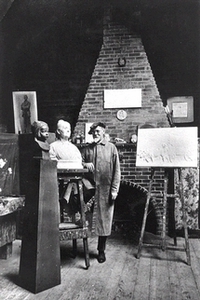CYRUS EDWIN DALLIN

Cyrus Edwin Dallin
Cyrus Edwin Dallin was an American sculptor and educator. He was born in 1861 in a log cabin at Springville, Utah of Mormon pioneers parents, Thomas and Jane Hamer Dallin, and developed an early interest in art and Indian life while herding animals and attending Springville's one-room schools sponsored by the Presbyterian Church of which he became a member. At eighteen, the gifted youth moved to Boston, where he studied sculpture under Truman H. Bartlett. Within a short time he gained international recognition for his monumental, award-winning, equestrian statues of American Indians and patriot leaders. To prove himself he twice studied sculpture in Paris under master teachers, Michael Chapu and Jean Dampt at the Julian Academie and Ecole des Beaux-Arts.
During his first visit to Paris in 1890, Dallin learned that Buffalo Bill and his Wild West company were performing in that city. Cyrus was drawn to their encampment where he worked side by side with the famous animal painter, Rosa Bonheur, and modeled a statue of a mounted Indian, titled Signal of Peace, which won an honorable mention at the Paris Salon. He later became a respected sculpture instructor at the Massachusetts School of Art, as well as a civic leader and archery champion, making his permanent family residence at Arlington Heights, Massachusetts.
Upon his marriage to Vittoria Colonna Murray of Boston in 1891, Dallin returned to Utah for a few years to create the Angel Moroni for the Salt Lake City LDS Temple as well as the Brigham Young Monument on Main Street. In 1895, he taught sculpture for one year at the Drexel Institute in Philadelphia where he completed a figure of Sir Isaac Newton for the Library of Congress at Washington, D.C.
Dallin's dramatic, realistic style of sculpture includes nearly 250 known works, many reproduced in plaster and bronze statuettes. Some in heroic size (double life-size) are located in American's largest cities: Signal of Peace (1890), Lincoln Park, Chicago; Medicine Man (1899), Fairmount Park, Philadelphia; Appeal to the Great Spirit (1909 in front of the Boston Museum of Fine Arts; Menotomy Indian Hunter (1911), Town Hall, Arlington, Mass; Scout (1914), Penn Valley Park, Kansas City, Missouri; Massasoit (1920) Plymouth, Mass. and State Capitol grounds, Salt Lake City, Utah and Passing of the Buffalo (1929), Muncie, Indiana. With these works Dallin graphically portrays the dignity and evolving plight of the red man's struggle against the inhumane and unjust treatment of the intruding white man.
Dallin also experienced prejudices and injustices in his bitter negotiations with dishonorable white men. He struggled for over a half century to get Boston to fulfill its many promises to erect his equestrian statue of Paul Revere near the Old North Church in Boston's north end. Dallin's gift of one of his rejected Revere models to his hometown in 1903 initiated the origin of the Springville Museum of Art, an institute he warmly praised: "The events of my youth are my dearest possessions. I have received two college degrees: Master of Art, and Doctor of Art, besides medals galore, but my greatest honor of all is, 'I came from Springville, Utah.'"
Disclaimer: Information on this site was converted from a hard cover book published by University of Utah Press in 1994. Any errors should be directed towards the University of Utah Press.